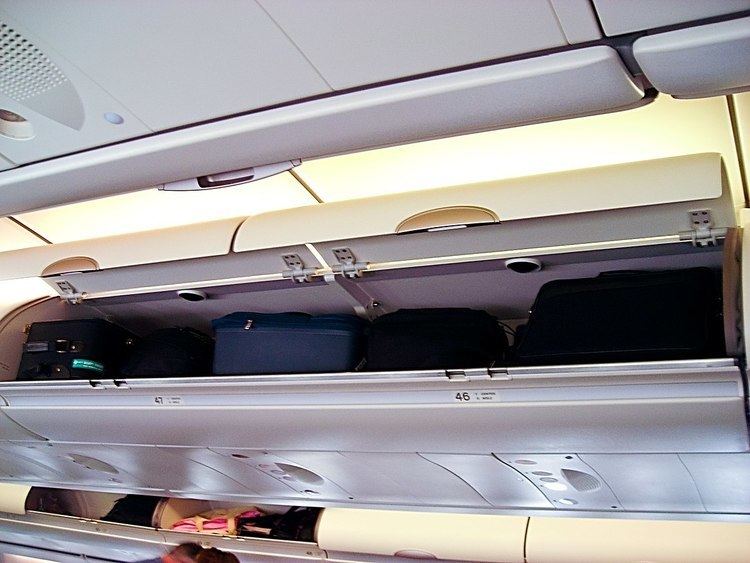 | ||
The term hand luggage or cabin baggage (also commonly referred to as carry-on in North America) refers to the type of luggage that passengers are allowed to carry along in the passenger compartment of a vehicle instead of moving to the cargo compartment. Passengers are allowed to carry a limited number of smaller bags with them in the vehicle and contain valuables and items needed during the journey. There is normally storage space provided for hand luggage, either under seating, or in overhead lockers. Trains usually have luggage racks above the seats and may also (especially in the case of trains travelling longer distances) have luggage space between the backs of seats facing opposite directions, or in extra luggage racks, for example, at the ends of the carriage near the doors.
Contents
Commercial air travel
Hand baggage allowance is a topic frequently discussed in context of commercial air travel. On one hand, passengers may want to have more of their possessions at hand during flight, skip often time-consuming baggage claim process, and avoid the risk of having their checked baggage lost or damaged. On the other hand, safety concerns, takeoff weight limitations and financial incentives cause airlines to impose limits on how much and what can a passenger take into the cabin of aircraft.
Cabin baggage allowances
The International Air Transport Association (IATA) sets guidelines for cabin baggage/hand luggage/carry-on luggage size. They are not mandatory, however, and individual airlines can and do vary their requirements. The IATA guideline at one time stated:
Cabin baggage should have a maximum length of 56 cm (22 inches), width of 45 cm (18 inches) and depth of 25 cm (10 inches) including all handles, side pockets, wheels etc.
The actual size and weight limits of cabin baggage can differ widely, in some cases they are dependent on the aircraft model being used, in other cases it depends on the booking class. Due to the lack of standardization a large number of different specifications were created by the airlines on the maximum permitted cabin luggage restrictions (see below). In 2015 the IATA made an effort to introduce a common smaller size for cabin luggage by introducing the "IATA Cabin OK" logo. Major airlines have expressed their interest to accept luggage of that size on their flights. This is specified as 55 x 35 x 20 cm (or 21.5 x 13.5 x 7.5 inches). There were news that the move was backed by nine airlines including Lufthansa, Emirates and Qatar Airlines. The new size restrictions were criticised widely with the introduction program to be put on hold a few days later. Consequently none of the mentioned airlines has introduced the new format (by April 2016).
Dimensions are sometimes listed as "linear", meaning the height, width, and length are not to exceed a certain total number.
Business Class, First class passengers and holders of high level mileage club members are often allowed to carry on a second bag of the same size and weight, or a smaller size and weight.
On smaller sized aircraft, sometimes the hand baggage can be carried to the aircraft door, where it is collected by baggage handlers for stowing in the cargo area and returned to the passenger right after landing.
Security restrictions
Following the increase in restrictions imposed on flights from UK airports and to the USA after the events of August 2006 transatlantic aircraft plot, hand baggage on such flights was restricted to one cabin bag no bigger than 45 cm × 35 cm × 16 cm effective since 15 August. On 21 September 2006, the British Airports Authority advised that from the following day, the allowable size of the single item of hand baggage on outgoing flights from the UK would be increased to 56 cm × 45 cm × 25 cm (approx. 22 in × 17.75 in × 9.85 in), the IATA guideline size. Most UK airports remain to have a strict limit of one piece of cabin baggage per passenger, including business class (allowed two pieces of cabin baggage within Europe, excluding flights to and from the UK).
European Union
A common regulation for cabin baggage restrictions was introduced on 6 November 2006 in European Union and in Switzerland, Norway and Iceland.
United States
The United States Transportation Security Administration (TSA) has introduced a series of restrictions effective since 26 September 2006 under the name "3:1:1" for liquids.
The TSA has additional restrictions for security searches: for example, the baggage should not be locked (except with a special luggage locks that TSA staff can open), gifts should not be wrapped, and shoes may be required to be taken off during body search with the metal detector. Food items in the luggage may be mistaken for dangerous material triggering an intensive search.
